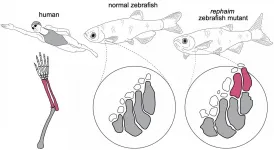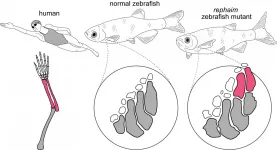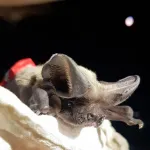(Press-News.org) BUFFALO, N.Y. -- All things being equal, large, long-lived animals should have the highest risk of cancer.
The calculation is simple: Tumors grow when genetic mutations cause individual cells to reproduce too quickly. A long life creates more opportunities for those cancerous mutations to arise. So, too, does a massive body: Big creatures -- which have many more cells -- should develop tumors more frequently.
Why, then, does cancer rarely afflict elephants, with their long lifespans and gargantuan bodies? They are some of the world's largest land animals.
A new study delves into this sizeable mystery, showing that elephants possess extra copies of a wide variety of genes associated with tumor suppression.
But this phenomenon is not unique to elephants, scientists say: The research concluded that duplication of tumor suppressor genes is quite common among elephants' living and extinct relatives, including in small ones like Cape golden moles (a burrowing animal) and elephant shrews (a long-nosed insectivore). The data suggest that tumor suppression capabilities preceded or coincided with the evolution of exceptionally big bodies, facilitating this development.
The study was published on Jan. 29 in the journal eLife by biologists Vincent Lynch at the University at Buffalo and Juan Manuel Vazquez at the University of California, Berkeley.
"One of the expectations is that as you get a really big body, your burden of cancer should increase because things with big bodies have more cells," says Lynch, PhD, assistant professor in the Department of Biological Sciences in the UB College of Arts and Sciences. "The fact that this isn't true across species -- a long-standing paradox in evolutionary medicine and cancer biology -- indicates that evolution found a way to reduce cancer risk."
In the new study, "We explored how elephants and their living and extinct relatives evolved to be cancer-resistant," Lynch says. "We have past research looking at TP53, a well-known tumor suppressor. This time, we said, 'Let's just look at whether the entire elephant genome includes more copies of tumor suppressors than what you'd expect.' Is the trend general? Or is the trend specific to one gene? We found that it was general: Elephants have lots and lots and lots of extra copies of tumor suppressor genes, and they all contribute probably a little bit to cancer resistance."
Elephants do have enhanced cancer protections, compared with relatives
Though many elephant relatives harbor extra copies of tumor suppressor genes, the scientists found that elephant genomes possess some unique duplications that may contribute to tumor suppression through genes involved in DNA repair; resistance to oxidative stress; and cellular growth, aging and death.
"By determining how big, long-lived species evolved better ways to suppress cancer, we can learn something new about how evolution works and hopefully find ways to use that knowledge to inspire new cancer treatments," says Vazquez, PhD, a postdoctoral researcher at UC Berkeley who completed much of the project while earning his PhD at the University of Chicago.
A related mystery: How did giant sloths and ancient mega-armadillos get so big?
Elephants are a great case study for understanding the evolution of cancer protection because they belong to a group of mammals -- the Afrotherians -- that are mostly small-bodied.
The study searched for extra copies of tumor suppressor genes in the DNA of Asian, African savanna and African forest elephants, as well as in the genomes of a number of fellow Afrotherians, such as Cape golden moles, elephant shrews, rock hyraxes, manatees, extinct woolly mammoths, extinct mastodons and more. The team also studied certain species belonging to a group of mammals called Xenarthra that is closely related to Afrotherians, and found some extra copies of tumor suppressors in those animals' genomes as well.
Given the findings, Lynch wonders whether the duplication of tumor suppressors may have aided the evolution of other ancient large bodies within these groups.
"If you pick a weird mammal, there's a good chance that it will be in these groups, the Afrotherians and Xenarthrans: armadillos, aardvarks, sloths, anteaters, all of these weird mammals," Lynch says. "We found that within these groups of organisms, the ones we studied all seem to have extra copies of tumor suppressor genes. That may be why in the last Ice Age, there were giant sloths and ancient mega-armadillos. There's even an extinct species of manatee relative called the Steller's sea cow that was elephant-big. Extra copies of tumor suppressors may have helped all of these animals get really, really big."
INFORMATION:
Laparoscopic surgery, a less invasive alternative to conventional open surgery, involves inserting thin tubes with a tiny camera and surgical instruments into the abdomen. To visualize specific surgical targets, ultrasound imaging is used in conjunction with the surgery. However, ultrasound images are viewed on a separate screen, requiring the surgeon to mentally combine the camera and ultrasound data.
Modern augmented reality (AR)-based methods have overcome this issue by embedding ultrasound images into the video taken by the laparoscopic camera. These AR methods precisely map the ultrasound data coordinates to the coordinates of the ...
Over the past 30 years, the use of soil fumigants and nematicides used to protect cole crops, such as broccoli and Brussel sprouts, against cyst nematode pathogens in coastal California fields has decreased dramatically. A survey of field samples in 2016 indicated the nematode population has also decreased, suggesting the existence of a natural cyst nematode controlling process in these fields.
Thanks to California's pesticide-use reporting program, nematologists have been able to follow the amounts of fumigants and nematicides used to control cyst nematodes over the past three decades.
"Application of these pesticides steadily declined until they were completely eliminated in ...
As the coronavirus pandemic continues to devastate communities worldwide, Black Americans who face racial discrimination in hospitals and doctor's offices weather additional stresses that can exacerbate threats from COVID-19. A new University of Georgia study examines the interplay between the perceptions of coronavirus threat and psychological distress among Black Americans.
The additional stresses arise from the prevalent belief among Black Americans worried that they might not recover from how hospitals treat them if they become infected with the coronavirus.
"While the notion has been floated among commentators, this is the first study that uses nationally representative data to assess whether this threat, or feeling, ...
BOSTON - Tiny particles of air pollution -- called fine particulate matter -- can have a range of effects on health, and exposure to high levels is a known risk factor for cardiovascular disease. New research led by investigators at Massachusetts General Hospital (MGH) reveals that fine particulate matter has a detrimental impact on cardiovascular health by activating the production of inflammatory cells in the bone marrow, ultimately leading to inflammation of the arteries. The findings are published in the END ...
By tweaking a single gene, Harvard scientists engineered zebrafish that show the beginning formation of limb-like appendages. The researchers stumbled upon this mutation, which may shed light on the sea-to-land transition of vertebrates, while screening for various gene mutants and their impact on fish development. Their discovery, outlined February 4th in the journal Cell, marks a fundamental step in our understanding of fin-to-limb evolution and how surprisingly simple genetic changes can create great leaps in the development of complex structures.
"It was a little bit unbelievable that just one mutation was able to create completely new bones and joints," says M. Brent Hawkins (@Homeobox), first author of ...
Fin-to-limb transition is an icon of key evolutionary transformations. Many studies focus on understanding the evolution of the simple fin into a complicated limb skeleton by examining the fossil record. In a paper published February 4 in Cell, researchers at Harvard and Boston Children's Hospital examined what's occurring at the genetic level to drive different patterns in the fin skeleton versus the limb skeleton.
Researchers, led by M. Brent Hawkins, a recent doctoral recipient in the Department of Organismic and Evolutionary Biology, performed forward genetic screens in zebrafish looking for mutations that affect the fin skeleton. Unlike tetrapod limbs, which have complex skeletons with many bones that articulate ...
Although scientists knew that some bats could reach heights of over 1,600 meters (or approximately one mile) above the ground during flight, they didn't understand how they managed to do it without the benefit of thermals that aren't typically available to them during their nighttime forays. Now, researchers reporting in the journal Current Biology on February 4th have uncovered the bats' secret to high-flying.
It turns out that the European free-tailed bats they studied--powerful fliers that the researchers documented sometimes reaching speeds of up to 135 kilometers (84 miles) per hour in self-powered flight--do depend on orographic uplift that ...
As the planet warms, glaciers are retreating and causing changes in the world's mountain water systems. For the first time, scientists at the University of Oxford and the University of Washington have directly linked human-induced climate change to the risk of flooding from a glacial lake known as one of the world's greatest flood risks.
The study examined the case of Lake Palcacocha in the Peruvian Andes, which could cause flooding with devastating consequences for 120,000 residents in the city of Huaraz. The paper, published Feb. 4 in Nature Geoscience, provides new evidence for an ongoing legal case that hinges on the link between greenhouse gas emissions and particular climate change impacts.
"The scientific challenge was to provide the clearest and cleanest assessment ...
CHICAGO - A new study by Northwestern University researchers finds involvement with firearms by high-risk youth is associated with firearm violence during adulthood.
"Association of Firearm Access, Use, and Victimization During Adolescence with Firearm Perpetration During Adulthood in a 16-year Longitudinal Study of Youth Involved in the Juvenile Justice System" will publish in JAMA Network Open at 10 a.m. CST, Thursday, Feb. 4. Access the full study online.
The longitudinal study of juvenile justice youth is the first to analyze firearm victimization and access during adolescence and its association with firearm violence in adulthood.
The study is based ...
Toronto - (February 4, 2021) The results of a Phase III randomized clinical trial have shown that when it comes to detecting clinically significant prostate cancer, Magnetic Resonance Imaging (MRI) with targeted biopsies (MRI-TBx) matches the current standard and brings a multitude of advantages. The PRostate Evaluation for Clinically Important Disease: MRI vs Standard Evaluation Procedures (PRECISE) study will help to make prostate cancer diagnosis more accurate and less invasive.
PRECISE included 453 participants at Canadian academic cancer centres who were either assigned to receive MRI ...




